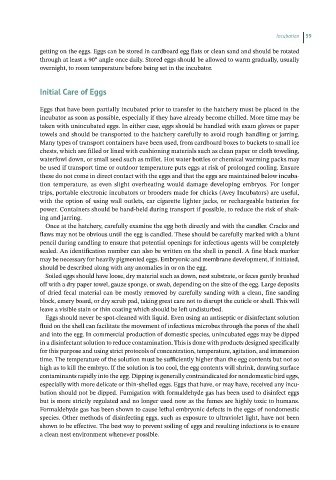Page 76 - Hand rearing birds second
P. 76
Incubation 59
getting on the eggs. Eggs can be stored in cardboard egg flats or clean sand and should be rotated
through at least a 90° angle once daily. Stored eggs should be allowed to warm gradually, usually
overnight, to room temperature before being set in the incubator.
InitialCareof Eggs
Eggs that have been partially incubated prior to transfer to the hatchery must be placed in the
incubator as soon as possible, especially if they have already become chilled. More time may be
taken with unincubated eggs. In either case, eggs should be handled with exam gloves or paper
towels and should be transported to the hatchery carefully to avoid rough handling or jarring.
Many types of transport containers have been used, from cardboard boxes to buckets to small ice
chests, which are filled or lined with cushioning materials such as clean paper or cloth toweling,
waterfowl down, or small seed such as millet. Hot water bottles or chemical warming packs may
be used if transport time or outdoor temperature puts eggs at risk of prolonged cooling. Ensure
these do not come in direct contact with the eggs and that the eggs are maintained below incuba-
tion temperature, as even slight overheating would damage developing embryos. For longer
trips, portable electronic incubators or brooders made for chicks (Avey Incubators) are useful,
with the option of using wall outlets, car cigarette lighter jacks, or rechargeable batteries for
power. Containers should be hand‐held during transport if possible, to reduce the risk of shak-
ing and jarring.
Once at the hatchery, carefully examine the egg both directly and with the candler. Cracks and
flaws may not be obvious until the egg is candled. These should be carefully marked with a blunt
pencil during candling to ensure that potential openings for infectious agents will be completely
sealed. An identification number can also be written on the shell in pencil. A fine black marker
may be necessary for heavily pigmented eggs. Embryonic and membrane development, if initiated,
should be described along with any anomalies in or on the egg.
Soiled eggs should have loose, dry material such as down, nest substrate, or feces gently brushed
off with a dry paper towel, gauze sponge, or swab, depending on the size of the egg. Large deposits
of dried fecal material can be mostly removed by carefully sanding with a clean, fine sanding
block, emery board, or dry scrub pad, taking great care not to disrupt the cuticle or shell. This will
leave a visible stain or thin coating which should be left undisturbed.
Eggs should never be spot‐cleaned with liquid. Even using an antiseptic or disinfectant solution
fluid on the shell can facilitate the movement of infectious microbes through the pores of the shell
and into the egg. In commercial production of domestic species, unincubated eggs may be dipped
in a disinfectant solution to reduce contamination. This is done with products designed specifically
for this purpose and using strict protocols of concentration, temperature, agitation, and immersion
time. The temperature of the solution must be sufficiently higher than the egg contents but not so
high as to kill the embryo. If the solution is too cool, the egg contents will shrink, drawing surface
contaminants rapidly into the egg. Dipping is generally contraindicated for nondomestic bird eggs,
especially with more delicate or thin‐shelled eggs. Eggs that have, or may have, received any incu-
bation should not be dipped. Fumigation with formaldehyde gas has been used to disinfect eggs
but is more strictly regulated and no longer used now as the fumes are highly toxic to humans.
Formaldehyde gas has been shown to cause lethal embryonic defects in the eggs of nondomestic
species. Other methods of disinfecting eggs, such as exposure to ultraviolet light, have not been
shown to be effective. The best way to prevent soiling of eggs and resulting infections is to ensure
a clean nest environment whenever possible.

